Yun Liu - Research Highlights
Research Highlights
- The viscosity control of monoclonal antibody drugs
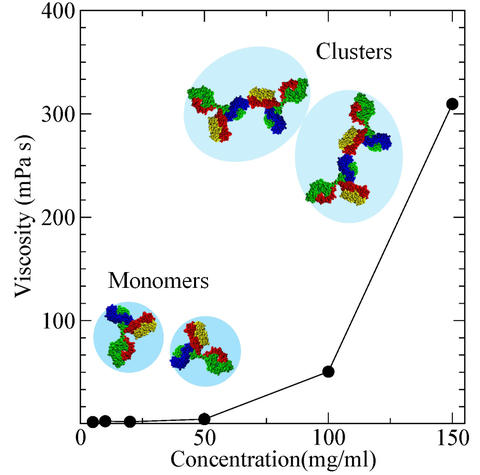
The viscosity of monoclonal (mAb) antibody solutions strongly depends on inter-protein structures. Using neutron scattering techniques, we can conclusively identify the possible formation of small reversible protein clusters in concentrated mAb solutions. The increased viscosity of some mAb solutions are seen to be driven by the formation of protein clusters. See press reports at the following websites.
Chemical & Engineering News "Why Monoclonal Antibody Drugs Get Sticky"
Department of Commerce "NIST Research Offers Guide in Formulating Cancer Treatment Drugs"
NIST "NIST Helps Cancer Treatment Drugs Get Past Their Sticking Point"
- Cluster formation in concentrated protein solutions. (Highlight by Institut Laue-Langevin, France)
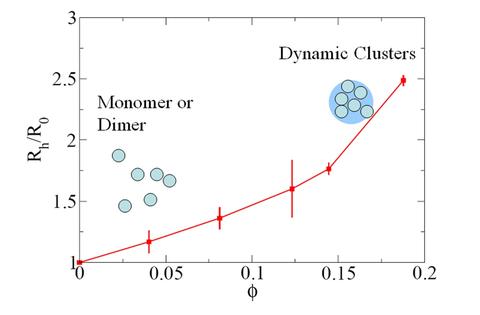
By probing the short-time dynamics in concentrated lysozyme solutions, we have conclusively demonstrated the formation of dynamic clusters in lysozyme solutions. This method and experimental result are very useful to understand clustering effect during protein formulation in pharmaceutical industry.
- Safer, Denser Acetylene Storage in an Organic Framework. (Highlight by NIST tech beat.)
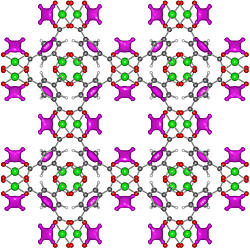
Our recent discovery of a MOF that has an extraordinarily high acetylene uptake has been highlighted by NIST Tech Beat.
(S. Xiang, W. Zhou, J. M. Gallegos, Y. Liu*, B. Chen*, "Exceptionally High Acetylene Uptake in a Microporous Metal-Organic Framework with Open Metal Sites", J. of the American Chemical Society 131, 12415-12419 (2009).)
See press report also at:
- More Solid than Solid: A Potential Hydrogen-Storage Compound. (Highlight by NIST tech beat.)
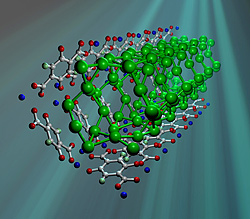
(Y. Liu, H. Kabbour, C. M. Brown, D. A. Neumann, C. C. Ahn, "Increasing the Density of Adsorbed Hydrogen with Coordinatively Unsaturated Metal Centers in Metal-organic Frameworks", Langmuir 24, 4772 (2008).)
See press reports also at:
- Hydrogen Storage Gets A Boost: Direct H2 binding to metal atoms beefs up capacity. (Highlight by Chemical & Engineering News.)
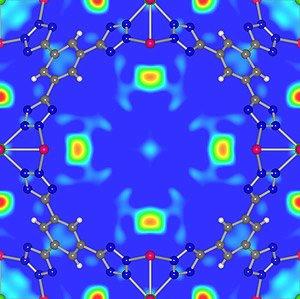
We have published a series of papers with our collaborators using neutron scattering techniques to conclusively demonstrate that the open metal sites in many MOFs can strongly bind hydrogen molecules directly. This discovery has been cited as "a significant milestone in hydrogen storage" by C&EN in 2007. (See the resport in C&EN).
See the highlight also at University of Maryland.
1) M. Dinca, A. Dailly, Y. Liu, C. M. Brown, D. A. Neumann, J. R. Long, "Hydrogen Storage in a Microporous Metal-Organic Framework with Exposed Mn2+ Coordination Sites", J. of the American Chemical Society 128, 16876 (2006).
(Highlighted by Chemical & Engineering News, Vol. 85, 11 (2007) http://pubs.acs.org/cen/news/85/i01/8501notw8.html. "Hydrogen Storage Gets A Boost: Direct H2 binding to metal atoms beefs up capacity").
(Ranked as one of Journal of the American Chemical Society's Hot Papers: Nov. 2007, January, March, and May 2008)
2) V. K. Peterson, Y. Liu, C. M. Brown, C. J. Kepert, "Neutron Powder Diffraction Study of D2 Sorption in Cu3(1,3,5-benzenetricarboxylate)2", J. of the American Chemical Society 128, 15578 (2006).
(Highlighted by Chemical & Engineering News, Vol. 85, 11 (2007) http://pubs.acs.org/cen/news/85/i01/8501notw8.html. "Hydrogen Storage Gets A Boost: Direct H2 binding to metal atoms beefs up capacity").

